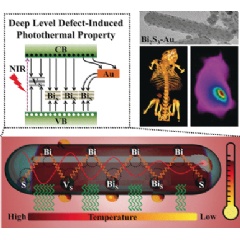Tumors Heat Up: New method for more effective photothermal tumor therapy with infrared light
Nanorods made of bismuth sulfide kill tumor cells with heat when they are irradiated with near-infrared light (NIR). Chinese scientists are now making these weapons more powerful by remodeling the defect state of the nanorod crystal lattice by adding gold nanodots. As reported in the journal Angewandte Chemie, this could be a good basis for more effective photothermal treatment of tumors.
In photothermal therapy, an agent is introduced into a tumor and then the region is irradiated with NIR light, a wavelength that penetrates far into tissue without causing damage. The agent absorbs the NIR light and converts it to heat. The local overheating kills off the tumor cells while healthy tissue is protected. Ideally, the photothermal agent can simultaneously act as a contrast agent for diagnostic imaging, such as computed tomography (CT), which can be used to locate the tumor.
Nanomaterials made from the semiconductor bismuth sulfide (Bi2S3) are well suited for this job. Researchers working with Haiyuan Zhang at the Chinese Academy of Sciences (Changchun, Jilin, China) have now been able to clarify the mechanisms that underlie the photothermal properties of these materials. Building on this knowledge, they have been able to improve the photothermal performance of bismuth sulfide nanorods by adding gold nanodots to their surface.
In simple terms, it works like this: In semiconductors, light can excite negatively charged electrons to such a degree that they jump to a higher energy level called the conduction band. This leaves behind positively charged “holes”. Recombination of the electrons and holes releases energy, which is transferred into the crystal lattice, causing it to vibrate. This vibrational energy is released into the environment as heat. Certain defects, known as deep level defects, in the crystal lattice promote this type of electron–hole recombination.
In Bi2S3 nanomaterials, which are synthesized in an excess of Bi and a shortage of S, the lattice will have locations with missing sulfur atoms or places in which a Bi replaces an S. Both of these can act as deep defects. Increasing the number of deep defects or increased introduction of electrons to these deep defects could increase the photothermal efficacy of Bi2S3nanomaterials. This is where the gold atoms play a role. Gold atoms bind sulfur atoms and keep them out of their lattice positions. This results in more defects. In addition, the contact points between the Bi2S3 and gold provide the excited electrons with an energy level that allows them to return more easily to the energy level where there are substitution errors, allowing the electrons to fall more easily into the deep defect “trap”.
The nanorods are very visible as contrast agents in CT scans of tumors in mice, because they preferentially aggregate in tumor cells. Inhibition of tumor growth with the gold version of the nanorods under irradiation with NIR was significantly increased over gold-free nanorods. After fourteen-day treatment of the mice, some of the tumors had completely disappeared. No toxic side effects or damage were observed in the surrounding tissue.
About the JournalAngewandte Chemie is a journal of the Gesellschaft Deutscher Chemiker (German Chemical Society, GDCh) and is published by Wiley-VCH. It is one of the prime chemistry journals in the world.
( Press Release Image: https://photos.webwire.com/prmedia/6/217649/217649-1.gif )
WebWireID217649
This news content was configured by WebWire editorial staff. Linking is permitted.
News Release Distribution and Press Release Distribution Services Provided by WebWire.
